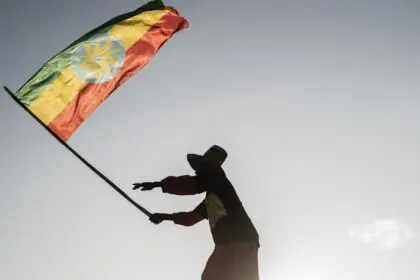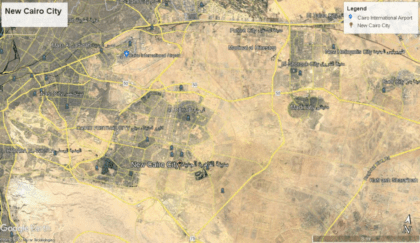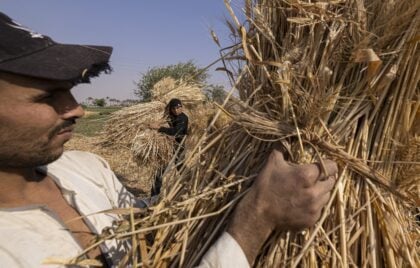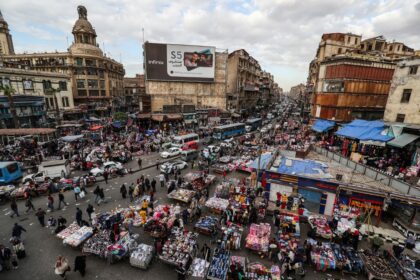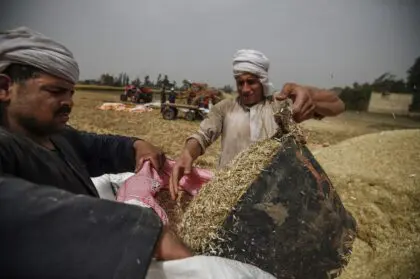
Introduction
Egypt lies on the northeastern corner of the African continent, where most of the economic activity takes place. The highly fertile Nile Valley is another reason for strong economic activity.
The Egyptian economy was highly centralised under former President Gamal Abdel Nasser, but it fully opened under former Presidents Anwar Sadat and Hosni Mubarak. Agriculture, hydrocarbons, manufacturing, tourism, and other service sectors have led to relatively diverse economic activity.
Egypt’s mixed record of attracting foreign investment over the past two decades, poor living conditions and limited employment opportunities contributed to public resentment. These social and economic pressures led to a civil uprising in January 2011 that toppled President Mubarak. The unstable political, security, and political environment since 2011 has restricted economic growth and failed to alleviate persistent unemployment, especially among young people.
In late 2016, the continuing depreciation of the US dollar and the decline in assistance from Gulf allies led to Egypt resorting to the International Monetary Fund (IMF) for a three-year loan of $12 billion. Cairo floated its currency to secure the deal, it introduced new taxes and reduced energy subsidies – all pushing inflation above 30per cent for most of 2017. Before the floating decision of the third of November 2016, the dollar’s exchange rate against the Egyptian pound was 8.85 pounds per dollar, but with the floating decision, the Central Bank of Egypt put the rate at 13.52 pounds. However, the United States currency continued to make record jumps to its highest rate against the Egyptian pound in the second half of 2017, when the dollar’s exchange rate jumped to about 19.60 pounds, recording record levels in the Egyptian exchange market, rising by approximately 121.46per cent.
The depreciation of the US dollar began at the end of 2017, with the dollar losing about 4 pounds of value until the last quarter of 2021, when its exchange rate hovered to about 15.6 pounds, a decline of about 20per cent, in nearly three years. Macroeconomic conditions have improved as Egypt’s double deficit has shrunk and inflation has declined sharply.
The central bank had cut key interest rates for the first time since the tightening cycle that accompanied the exchange rate hike in November 2016. Economic activity began to recover, and the unemployment rate fell below 12per cent for the first time since 2011.
The growth rate of the Egyptian economy was 5.2 per cent in the first half of the fiscal year of 2018, compared to 3.7 per cent in the previous fiscal year, according to World Bank reports, driven mainly by investment, exports, and consumption. The gas industry sector had been a significant contributor to growth, particularly since the actual operation of the large “back” gas field in mid-December 2018. Improvements in energy supply are beginning to affect other sectors positively, particularly the manufacturing industry. The tourism sector is also gradually recovering, helped by the impact of the devaluation of the local currency.
The emerging economic recovery was accompanied by a steady decline in the unemployment rate, which fell to its lowest level since the middle of the fiscal year 2010/2011, to 9.8 per cent in the fiscal year 2018/2019, before rising again by 0.3 per cent in the following fiscal year 2019/2020.
The reform measures taken with IMF support have been harsh – but necessary – for the sake of the health of the economy. Steps taken to improve the regulatory framework and reduce bureaucratic inefficiency have also been essential and will remain a priority. This is because improving the ease of doing business creates jobs and allows families to improve their lives, and their children’s lives.
Financial action has strengthened the Government’s financial position and enabled it to manage the effects of the Covid-19 pandemic. According to IMF reports, the pandemic was a massive shock to the Egyptian economy, as in most rising markets. One of its repercussions was the sudden cessation of tourism.
At the beginning of the crisis, tourism contributed about 12 per cent of GDP, providing about 10 per cent of employment and 4 per cent of GDP in foreign currencies. Preventive measures to contain and prevent the spread of HIV, including partial public closures and restrictions on the absorptive capacity of public places have led to a temporary decline in local activities.
In contrast, the Government’s budget has come under pressure because the slowdown in economic activity has resulted in lower tax revenues. Egypt also experienced large capital inflows of over $15 billion during March-April 2020, as investors pulled out of rising markets for safer investments. However, Egypt was one of the few emerging market countries to achieve a positive growth rate in 2020 thanks to a timely response from the Government and the support of the International Monetary Fund (IMF). The Egyptian economy showed resilience in the face of the pandemic, despite the short period of general closure and a relatively diverse Egyptian economy.
Gross Domestic Product of Egypt
Despite ambitious measures to regulate public finances, the re-emergence of COVID-19 cases has cast a shadow over this nascent economic recovery in Egypt. According to the World Bank, these pressures are due to foreign income sources that have been severely affected (tourism, commodity exports, and foreign direct investment). Yet remittances, inflows of investment portfolios, and external financing still support international reserves.
Preliminary results indicated that Egypt’s Gross Domestic Product (GDP) grew by 3.3 per cent during the 2020/2021 fiscal year, despite significant challenges faced by the Egyptian economy during the previous fiscal year due to the fallout of the pandemic. GDP growth in the fourth quarter of the fiscal year 2020/2021 jumped to about 7.7 per cent compared to about -1.7 per cent in the same period in the previous fiscal year 2019/2020 (April-June).
The pandemic affected annual GDP growth rates, with economic growth falling during the 2019/2020 fiscal year to 3.6 per cent, compared to 5.6 per cent achieved during 2018/2019.
The real growth rate decreased from 5.6 per cent in the fiscal year 2018/2019 to 3.6 per cent in 2019/2020, with the pandemic causing an annual contraction of 1.7 per cent between April and June (fourth quarter 2019/2020). Growth increased in July to September and October to December (the first quarter and the second quarter of the fiscal year 2020/2021), with the lifting of the night curfew and the easing of social restrictions. However, it remained low at 0.7 per cent and 2 per cent respectively.
Unemployment had fallen to 7.2 per cent by the second quarter of the fiscal year 2020/2021 (after a rapid rise of 9.6 per cent in the six months before). The initial decline in total employment was reversed as a result of the reemergence of Covid-19 cases across the country.
According to the World Bank, labour force participation rates recovered from the significant initial reduction; However, they remained below potential at 43.5 per cent and 40.4 per cent of the working-age population in important sectors, such as tourism and industrialization.
However, the negative consequences of the pandemic undermined recent progress and highlighted long-standing challenges. Some of the aforementioned challenges include: the slowdown in non-oil activity of the private sector, the weak performance of exports and foreign direct investment, the high ratio of government debt to gross domestic product, the low rates of revenue mobilisation below the hoped-for level, the inadequate structure of the State budget to tackle the crisis, and low spending in the health and education sectors.
Macroeconomic reforms in Egypt had helped stabilise the economy in recent years and had allowed the country to enter the Covid-19 crisis with improved public treasury accounts and a relatively high level of foreign reserves. Energy sector reforms have helped boost electricity supply and gas exports, opening up the energy market to private sector activity, particularly renewable energy. This has enabled avoiding falling into the trap of economic deflation.
The World Bank recommended that Egypt advance macroeconomic and public finance reform as well as structural reforms, strengthen social protection, advance the human capital agenda, and implement measures to contain the pandemic to achieve a solid economic recovery.
Industry
As part of an ongoing effort by the industrial sector to support the Egyptian industrial base and push the Egyptian industrial product into a suitable position in foreign markets, production capacity in a number of primary industries has increased by 25 per cent since the mid-1990s, until the uprising in January 2011, according to the State Information Service, a government source. In addition, the Egyptian industry has been able to develop within new fields, such as advanced technology and microelectronics.
Egypt’s industrial structure is based on seven industries, comprising more than 80 per cent of industrial enterprises. The three most extensive industrial activities are concentrated in the textile, food, beverage, and furniture industries, followed by mining, chemical, and bare metal industries.
Regarding the country’s manufacturing trends, the total number of manufacturing enterprises fell by 19.59 per cent to 6,948 (operating in 423 industries) during 2020, compared to 8,641 (operating 472 sectors) in 2019. In terms of relative importance, the total number of highest working enterprises in 15 manufacturing industries was 2,080, representing 29.94 per cent of the total number of manufacturing enterprises in 2020.
The development of manufacturing industries in Egypt during the year 2020 compared to 2019:
| ranking | Industry | Number of establishments per year | growth rate (%) | |
| 2019 | 2020 | |||
| 1 | Various clothes of fabrics | 237 | 428 | 80.59 |
| 2 | Plastic rolls, bags, packages and boxes | 235 | 197 | -16.17 |
| 3 | Food packaging | 329 | 187 | -43.16 |
| 4 | wooden furniture | 266 | 138 | -48.12 |
| 5 | medical clothes | 27 | 126 | 366.67 |
| 6 | Distribution and control switches and electrical panels | 76 | 124 | 63.16 |
| 7 | Various plastic products | 132 | 119 | -9.85 |
| 8 | Various textiles | 77 | 107 | 38.96 |
| 9 | Various shoes | 48 | 104 | 116.67 |
| 10 | Metal parts for various industries | 139 | 98 | -29.50 |
| 11 | soap | 49 | 94 | 91.84 |
| 12 | popular bread | 364 | 91 | -75.00 |
| 13 | Working, cutting, polishing, shaping natural stones | 111 | 90 | -18.92 |
| 14 | Wooden doors and windows | 160 | 89 | -44.38 |
| 15 | blacksmithing | 138 | 88 | -36.23 |
| 16 | Other | 6,253 | 4,868 | -22.15 |
| Total | 8,641 | 6,948 | -19.59 | |
Source: Ministry of Trade and Industry.
Despite the challenges faced as a result of the Covid-19 pandemic, the industrial sector achieved positive performance indicators during the 2019/2020 fiscal year, with an industrial growth rate of 6.3 per cent; Industrial output accounted for about 17.1 per cent of GDP. The country’s industrial sector accounts for 28.2 per cent of total Egyptian employment, according to the Ministry of Commerce and Industry.
Keeping this in mind, it is important to recognize the importance of the industrial sector to the economic growth of Egypt, as it acts as the country’s engine. The promotion of the national industrial sector has become a strategic approach of the state and a high priority in sustainable economic development plans.
Work has been done to develop an integrated plan and implement several initiatives to upgrade and modernise this sector and deepen local industrialization through expanding the establishment of industrial complexes, providing production requirements and exceptional facilities to encourage investment. It has intertwined relations with many productions and service sectors and improved the competitiveness of the Egyptian product in the domestic and international markets. The manufacturing industry was reported to have achieved a positive growth rate during the 2019/2020 fiscal year of about 1.4 per cent. However, less than in its previous fiscal year of 2.8 per cent, but remained positive in the year of the pandemic.
Industry indicators (Financial year)
| Indicators | measuring unit | 2018/2019 | 2020/2019 | Change ± |
| value of industrial production | Billion dollar | 54.30 | 60.40 | 6.1 |
| Industry contribution to GDP | % | 16.40 | 17.10 | 0.7 |
| Employment in industry (of total employment) | % | 28.2% | 28.2% | – |
Source: Ministry of Industry and Trade.
Agriculture and Livestock
Agriculture:
The most important agricultural exports include citrus, potatoes, onions, strawberries, pomegranates, sweet potatoes, beans, fodder penguins, guava, peppers, mangoes, garlic, grapes, and melons.
According to World Bank data, the value of agriculture rose from $33.49 billion in 2019 to $41.78 billion in 2020, accounting for 11.51 per cent of GDP in 2020, compared to 11.05 per cent in 2019, an increase of 0.46 per cent.
Despite the Covid-19 pandemic and its consequences for international transport and trade, Egyptian agricultural exports in 2020 amounted to approximately 5.2 million tonnes or $2.2 billion, the main ones being citrus, potatoes, pomegranates, and grapes, according to local media citing the Ministry of Agriculture and Land Reclamation. This is excluding exports of manufactured and packaged agricultural products. Agricultural exports rose to more than 4.4 million tons between January and August 2021.
Egypt exported 5.4 million tonnes of farm products in 2019, most of which were citrus fruits (1,772,281 tonnes). Potatoes came in second place, with 687,842 tonnes. And in third place came onions, with 602,016 tonnes of onions. Finally, 120,000 tonnes of pomegranates were exported.
According to World Bank data, in 2019, 20.62 per cent of the total labour force was employed in agriculture, down from 1.04 per cent in 2018.
Livestock
The Egyptian Ministry of Agriculture estimates the size of Egypt’s livestock in early 2021 to be 6.5 million livestock and live animals.
The livestock in all governorates of Egypt include 3.8 million cows, including 200,000 imported cows, and 1.3 million buffalo. In addition, there were 2.7 million sheep, goats, and camels.
The proportion of meat self-sufficiency rose from 44 per cent in 2014 to 57 per cent in 2020, and the state aims to reach over 65 per cent in 2025.
Foreign Trade
According to the Central Bank of Egypt, during the fiscal year 2019/2020, Egypt had a deficit of $36.5 billion in the trade balance, about $1.5 billion lower than during the fiscal year 2018/2019. However, transactions with the outside world registered a total deficit in the balance of about $8.6 billion payments. The current account was experiencing near-stabilisation in the deficit during the 2019/2020 fiscal year. The second half of that year the deficit increased from $10.9 million in 2018/2019 to around $11.2 million due to the negative fallout from the Covid-19 pandemic.
However, the marked improvement in the trade balance of non-oil products and the rise in pro bono hedges have contributed to easing the shock on the Egyptian economy.
On the financial side, the impact of the global pandemic has been strongly reflected in the behaviour and movements of capital around the world, leading to massive financial inflows from global financial markets. Nevertheless, the capital and financial account of the Egyptian budget maintained a net inflow of some $5.4 billion, which helped to reduce the overall deficit.
The fiscal year 2019/2020 saw petroleum export earnings decline by 26.6 per cent from $11.6 billion in the year 2018/19, to just $8.5 billion. Non-petroleum export earnings increased by 5.7 per cent, to about $17.9 billion. According to the Central Bank of Egypt, this is mainly due to the increase in export earnings from semi-manufactured goods by 43.3 per cent, raw materials by 12.9 per cent, and finished goods by 7.5 per cent.
The largest share of export earnings in 2019/2020 was held by the private sector at 68.9 per cent, the public sector at 16.8 per cent, and the investment sector at 14.3 per cent.
In contrast, payments for commodity imports decreased by 5.5 per cent to about $62.8 billion. Both petroleum imports fell by about $2.6 billion, to about $8.9 billion, and non-petroleum imports by about $1.0 billion, to about $53.9 billion.
Total Egyptian exports recorded $2.7 billion in February 2021, an increase of 31.4 per cent on an annual basis; Total imports reached $6.1 billion in March 2021, an increase of 31.4 per cent on a yearly basis.
Poverty
According to a statement by the minister of Planning Hala El-Said, citing the results of an income, expenditure, and consumption research, the poverty rate in Egypt fell to 29.7 per cent in the fiscal year 2019/2020, compared to 32.5 per cent in 2017/2018. The rate of extreme poverty fell to 4.5 per cent compared to 6.2 per cent in 2017/2018.
The Central Bureau of Public Mobilisation and Statistics set the poverty line in the new census at £857 per month (approximately $55), compared to £736 per month (roughly $47.2) in 2018/2017. The government considers this to be the result of the success of the economic reform programme the Egyptian government had pursued since the float of the Egyptian pound in November 2016.
According to the World Bank, the unemployment rate in Egypt fell from 13.05 per cent in 2015 to 7.84 per cent in 2019. Due to the Covid-19 crisis, it jumped again to 9.17 in 2020.
The labour force participation rate and the employment rate recovered from their substantial initial fall but remained below their possible levels at 43.5 per cent and 40 per cent of the working population, respectively.
The average annual household income rose by 15 per cent to 69,100 Egyptian pounds (approximately US $4,430) during the 2019/2020 fiscal year, compared to 58,850 pounds in the 2017/2018 fiscal year.
The average household income in rural areas increased by 13.3 per cent, while in urban areas it jumped by 16.3 per cent, according to al-Mal daily, citing the results of a research by the Central Bureau of Public Mobilization and Statistics.
New Administrative Capital Project of Egypt
The New Administrative Capital Project aims to move the capital to create numerous housing and employment opportunities to address Egypt’s various issues. The large-scale project was announced by the Egyptian government at the Conference in Support and Development of the Egyptian Economy on March 13, 2015.
The new capital lies between the Greater Cairo Province and the Suez Canal Province near the regional ring road and the Cairo/Suez Road. The region is planned to be the seat of Parliament, the Presidency, key ministries, and foreign embassies. The project also includes a significant park and an international airport. The city’s total planned area is 170 acres, the estimated population after completion is 6.5 million, generating approximately 2 million employment opportunities.
The official spokesman of the company developing the Administrative Capital announced in September 2021 that the implementation rate of the first phase is 70 per cent. The first phase is located on 40,000 acres. It includes ten residential neighbourhoods, the government district, the Parliament, the administrative district, the opera site in the City of Culture and Arts, the business and banking district, the international airport, roads and bridges, the power station, water stations, Al-Fattah Al-Alim Mosque, and the Cathedral of the Nativity of Christ, both of which were opened in early 2019.
Tourism Sector of Egypt
Tourism witnessed several crises between 2011 and 2017, which began with the outbreak of the 25th January revolution and the subsequent events that affected the security situation and economic performance. These led to a 34.7 per cent drop in tourist numbers and a 47.9 per cent decrease in tourism revenues in the 2014/2015 fiscal year.
Several terrorist incidents in the Sinai resulted in losses of more than $1.5 billion in 2016. In addition, the bombing of a cathedral in December 2018 led to the cancellation of about 40 per cent of hotel reservations in Cairo over Christmas by visitors from Arab countries, especially the United Arab Emirates and Kuwait, as well as several East Asian and European countries.
Official statistics showed that the number of tourist arrivals had decreased by 41.9 per cent in July 2016, compared to the same month in 2015. Tourist companies experienced a 20 per cent drop in reservations in 2016 and have seen a staggering 75 per cent drop overall since 2011.
The number of Russian visitors to Egypt dropped with 60 per cent; 17.5 per cent less British tourists visited the country and the number of German tourists decreased with 10.4 per cent in 2017. However, Hurghada began receiving many foreign visitors who stopped travelling to Sinai. The tourism crisis forced hotel and tourist establishments to lay off 720,000 workers out of a total of 800,000 workers (90 per cent) in 2016 and 2017.
Tourism revenues reached only $500 million in the first quarter of 2016, a 66 per cent decrease compared to 2015, due to Russia’s withdrawal from the tourism market, which accounts for more than 40 per cent of the incoming tourism volume to Egypt, according to the State Information Service website.
By the fourth quarter of the 2016/2017 fiscal year, tourism revenues had risen to $1.5 billion, according to a Bloomberg report based on data provided by the Central Bank of Egypt. Despite the recovery of the sector, revenues are still far below the $11.6 billion generated in the 2009/2010 fiscal year.
A recent study on the development of tourism traffic to Egypt indicated that the tourism sector achieved strong growth during 2018 compared to the years following the 2011 revolution. Preliminary data showed that the number of tourists increased by 40 per cent in 2018, reaching around 11.6 million compared to 8.3 million in 2017.
As a result of the Covid-19 pandemic, with a global halt in travel and the closure of international borders for months in order to contain the spread of the virus, income from tourism plummeted more than 69 per cent during the year 2020. It reached around 4 billion USD compared to more than 13 billion USD in the year before.
While in 2019 13.1 million tourists had visited Egypt, the country received only 3.5 million visitors in 2020.
According to CAPMAS, Europeans accounted for 64.3 per cent of the total number of tourists in 2019, whereas Arab tourists accounted for 24.3 per cent, Americans 4.2 per cent and other nationalities 7.1 per cent.
Banking Sector
About 40 government and private banks operate in Egypt, most with foreign capital, including three Islamic banks. Egypt’s largest bank is the Egyptian National Bank, with over $48 billion in assets, the Bank of Egypt with $27 billion in assets, and the World Trade Bank, the third-largest bank in Egypt with an estimated $13.5 billion in assets.
The Private Bank of Egypt, the Bank of Egypt, and the Bank of Cairo are major banks that control 40 per cent of the banking sector. All banks in Egypt are supervised by the Central Bank (CBE) except for the Arab World Bank, the Nasser Social Bank, and the National Investment Bank due to special provisions in law.
The Central Bank of Egypt liberalised the exchange rate of the local currency (pound) under the economic reform programme recommended by the International Monetary Fund (IMF) to give Egypt a $12 billion loan on November 3, 2016. The loan provides banks operating in Egypt flexibility to price the purchase and sale of foreign exchange to restore its circulation within legitimate channels and eliminate the parallel foreign exchange market. The Egyptian pound lost almost half its value, dropping from 8.88 per dollar to 17.5 a year after the exchange rate was liberalised and about 17.8 after two years of floating, before settling at £15.6 to the dollar.
In August 2021, foreign exchange reserves rose to $40.672 billion from $40.609 billion in July of the same year, an increase of $63 million, according to Independent Arabia, citing the Egyptian Central Bank. Foreign exchange reserves have been rising since June 2020, after falling to about $36 billion from over $45.5 billion due to the impact of the Covid-19 pandemic.
The stimulus plan launched by the Egyptian government in March 2020 in response to the Covid-19 pandemic caused the cash reserve to rise from about $40 billion during the 2019/2020 fiscal year to about $40.2 billion during the 2020/2021 fiscal year.
Workforce

According to the World Bank, the unemployment rate in Egypt decreased from 13.05 per cent in 2015 to 7.84 per cent in 2019. However, it increased again to 9.17 per cent in 2020.
CNBC Arabia, citing official sources, reported that the unemployment rate in the second quarter of 2021 reached 7.3 per cent of the total labour force, a decrease of 2.3 per cent compared to the corresponding quarter in 2020.
According to an August 2021 statement by CAPMAS:
- 38.4 per cent of the young labour force has an average qualification.
- 22.6 per cent of the young labour force has a higher university qualification.
- 17.8 per cent of the young labour force has a lower-than-average qualification.
- 7.5 per cent of the young workforce are illiterate.
- 6.1 per cent of the young labour force reads, writes, and have certificates of literacy.
- 3.8 per cent of the young labour force has above-average and below-university qualifications.
- 3.7 per cent of the young labour force has a general/Azharitan secondary school diploma.
More than half of working youth, 56.2 per cent (of whom 53 per cent male, 80.4 per cent female), were employed permanently. Just over twenty per cent of the employees had a legal contract (of whom 15.7 per cent male, 54.2 per cent female).
The proportion of young people participating in social insurance was 23 per cent of the total employed (19.4 per cent male, 50.3 per cent female); The proportion of young people participating in health insurance was 17.9 per cent of the total number of workers (14 per cent male, 46.5 per cent female).
According to Egyptian authorities, the unemployment rate among workers in the age group 18- 29 years was 15.4 per cent (10.9 per cent males, 37.6 per cent females). The number of young people (between 18-29) in Egypt is estimated to be 21.3 million, 21 per cent of the total population (51.5per cent male, 48.5per cent female).
The unemployment rate among this group with a university qualification was 33.3 per cent (23.5 per cent male, 49.8 per cent female), compared to 12 per cent for those with an average technical staff (9.5 per cent male, 33.5 per cent female).
The World Bank estimates the unemployment rate of the labour force between the ages 15-24 to be 23.94 per cent in 2020.
Latest Articles
Below are the latest articles by acclaimed journalists and academics concerning the topic ‘Economy’ and ‘Egypt’. These articles are posted in this country file or elsewhere on our website:







